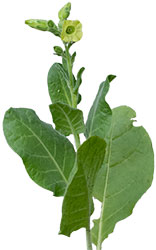Mapacho (Nicotiana rustica)
 Mapacho, ucuch, Aztec tobacco, (nicotiana rustica), is a rainforest plant in the Solanaceae family, with a long, sacred history to almost all of the indigenous people of North, Central and South America, and used in a many different preparations including drinks, snuffs, chews, lickable products, and of course, smoked. The effects come primarily from nicotine, but it also contains MAOIs. The Warao people of Venezuela have a particularly rich spirituality focused around hallucinogenic use of tobacco.
Mapacho, ucuch, Aztec tobacco, (nicotiana rustica), is a rainforest plant in the Solanaceae family, with a long, sacred history to almost all of the indigenous people of North, Central and South America, and used in a many different preparations including drinks, snuffs, chews, lickable products, and of course, smoked. The effects come primarily from nicotine, but it also contains MAOIs. The Warao people of Venezuela have a particularly rich spirituality focused around hallucinogenic use of tobacco.
History
Tobacco is probably the most sacred and revered plant of the Americas, with cultivation sites in Mexico dating back to 1000-1400 bce.
Use
Grandfather tobacco is used for many different purposes, and plays a critical role in ceremony for many cultures, including those that use other entheogens.
For the Native American peoples, tobacco is believed to carry prayers to Creator, and is required to communicate with the spirit world, and especially the spirits of other plants. It is the activator of plant spirits, and is always offered before picking medicines.
It is also used for cleansing through “smudging”, and also purging the body of toxins when used internally.
Tobacco does contain monoamine oxidase inhibitors (MAOIs), which can potentiate the effects of other plants.
Australia
Nicotiana benthamiana (tjuntiwari, muntju, tangungnu), Nicotiana gossei (ingulba, mingulba), and Nicotiana excelsior (pulandu, pulantu, balandu, pituri) are just a few of the sixteen species of tobacco native to Australia, with a long history of indigenous use.